Search results for: 'Quilt mac'
- Related search terms
- Machine fe
- Machine fiber
- Machine+fe
- machine de''
- machine ci'
-
 PRODUCTION EQUIPMENT#46. EMCO MULTI NEEDLE QUILTER #50. GRIBETZ DG 2200 BORDER QUILTER #52. 86” GRIBETZ QUILTER #53. TAPE EDGE GRIBETZ TPE012 #53. SINGER 300W SEWING MACHINES (3) #53. TAPE EDGE MACHINES #53. FUTON TAPE EDGE MACHINE #53. SINGER 300W SEWING MACHINES #54. HOT MELT #54. HOT MELT 1433242- GLUE MACHINE #54. PHOC001 6746 VE.0287 (PHOENIX CONVEYOR SYSTEMS) #54. HOT MELT MACHINE #54. FUTON FILLING MACHINE Learn More
PRODUCTION EQUIPMENT#46. EMCO MULTI NEEDLE QUILTER #50. GRIBETZ DG 2200 BORDER QUILTER #52. 86” GRIBETZ QUILTER #53. TAPE EDGE GRIBETZ TPE012 #53. SINGER 300W SEWING MACHINES (3) #53. TAPE EDGE MACHINES #53. FUTON TAPE EDGE MACHINE #53. SINGER 300W SEWING MACHINES #54. HOT MELT #54. HOT MELT 1433242- GLUE MACHINE #54. PHOC001 6746 VE.0287 (PHOENIX CONVEYOR SYSTEMS) #54. HOT MELT MACHINE #54. FUTON FILLING MACHINE Learn More -
 TT-5874 GRIBETZ 4300GI COMPUTER CHAINSTITCH TACK & JUMP QUILTER, 90”TT-5874 GRIBETZ 4300GI COMPUTER CHAINSTITCH TACK & JUMP QUILTER, 90” GRIBETZ 4300GI COMPUTER CHAINSTITCH TACK & JUMP QUILTER GRIBETZ QUILTER QUANTITY: 1 Learn More
TT-5874 GRIBETZ 4300GI COMPUTER CHAINSTITCH TACK & JUMP QUILTER, 90”TT-5874 GRIBETZ 4300GI COMPUTER CHAINSTITCH TACK & JUMP QUILTER, 90” GRIBETZ 4300GI COMPUTER CHAINSTITCH TACK & JUMP QUILTER GRIBETZ QUILTER QUANTITY: 1 Learn More -
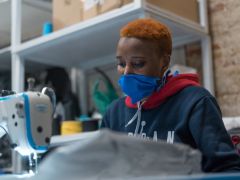 D-2388 What’s the Best Material for a Mask?
D-2388 What’s the Best Material for a Mask?Federal health officials have now recommended that we cover our faces with fabric during the coronavirus pandemic. But what material offers the most protection?
The Centers for Disease Control and Prevention has posted a no-sew mask pattern using a bandanna and a coffee filter as well as a video on making masks using rubber bands and folded fabrics found at home.
While a simple face covering can reduce the spread of coronavirus by blocking outgoing germs from coughs or sneezes of an infected person, experts say there is more variation in how much homemade masks might protect the wearer from incoming germs, depending on the fit and quality of the material used.
Scientists around the country have taken it upon themselves to identify everyday materials that do a better job of filtering microscopic particles. In recent tests, HEPA furnace filters scored well, as did vacuum cleaner bags, layers of 600-count pillowcases and fabric similar to flannel pajamas. Stacked coffee filters had medium scores. Scarves and bandanna material had the lowest scores, but still captured a small percentage of particles.
If you don’t have any of the materials that were tested, a simple light test can help you decide whether a fabric is a good candidate for a mask.
“Hold it up to a bright light,” said Dr. Scott Segal, chairman of anesthesiology at Wake Forest Baptist Health who recently studied homemade masks. “If light passes really easily through the fibers and you can almost see the fibers, it’s not a good fabric. If it’s a denser weave of thicker material and light doesn’t pass through it as much, that’s the material you want to use.”
Researchers say it’s important to remember that lab studies are conducted under perfect conditions with no leaks or gaps in the mask, but the test methods give us a way to compare materials. And while the degree of filtration for some homemade masks seems low, most of us — who are staying home and practicing social distancing in public — don’t need the high level of protection required for medical workers. More important, any face covering is better than none, especially if worn by a person who has the virus but doesn’t know it.
The biggest challenge of choosing a homemade mask material is to find a fabric that is dense enough to capture viral particles, but breathable enough that we can actually wear it. Some items being touted online promise high filtration scores, but the material would be unwearable.
Dressing Up for Work … at Home
Yang Wang, an assistant professor of environmental engineering at Missouri University of Science and Technology, worked with his graduate students to study various combinations of layered materials — including both air filters and fabric. “You need something that is efficient for removing particles, but you also need to breathe,” said Dr. Wang, who last fall won an international award for aerosol research.To test everyday materials, scientists are using methods similar to those used to test medical masks, which everybody agrees should be saved for medical workers who are exposed to high doses of virus from seeing infected patients. The best medical mask — called the N95 respirator — filters out at least 95 percent of particles as small as 0.3 microns. By comparison, a typical surgical mask — made using a rectangular piece of pleated fabric with elastic ear loops — has a filtration efficiency ranging from 60 to 80 percent.
Dr. Wang’s group tested two types of air filters. An allergy-reduction HVAC filter worked the best, capturing 89 percent of particles with one layer and 94 percent with two layers. A furnace filter captured 75 percent with two layers, but required six layers to achieve 95 percent. To find a filter similar to those tested, look for a minimum efficiency reporting value (MERV) rating of 12 or higher or a microparticle performance rating of 1900 or higher.
The problem with air filters is that they potentially could shed small fibers that would be risky to inhale. So if you want to use a filter, you need to sandwich the filter between two layers of cotton fabric. Dr. Wang said one of his grad students made his own mask by following the instructions in the C.D.C. video, but adding several layers of filter material inside a bandanna.
Dr. Wang’s group also found that when certain common fabrics were used, two layers offered far less protection than four layers. A 600 thread count pillow case captured just 22 percent of particles when doubled, but four layers captured nearly 60 percent. A thick woolen yarn scarf filtered 21 percent of particles in two layers, and 48.8 percent in four layers. A 100 percent cotton bandanna did the worst, capturing only 18.2 percent when doubled, and just 19.5 percent in four layers.
The group also tested Brew Rite and Natural Brew basket-style coffee filters, which, when stacked in three layers, showed 40 to 50 percent filtration efficiency — but they were less breathable than other options.
If you are lucky enough to know a quilter, ask them to make you a mask. Tests performed at the Wake Forest Institute for Regenerative Medicine in Winston-Salem, N.C., showed good results for homemade masks using quilting fabric. Dr. Segal, of Wake Forest Baptist Health, who led the study, noted that quilters tend to use high-quality, high-thread count cotton. The best homemade masks in his study were as good as surgical masks or slightly better, testing in the range of 70 to 79 percent filtration. Homemade masks that used flimsier fabric tested as low as 1 percent filtration, Dr. Segal said.
The best-performing designs were a mask constructed of two layers of high-quality, heavyweight “quilter’s cotton,” a two-layer mask made with thick batik fabric, and a double-layer mask with an inner layer of flannel and outer layer of cotton.
Bonnie Browning, executive show director for the American Quilter’s Society, said that quilters prefer tightly woven cottons and batik fabrics that stand up over time. Ms. Browning said most sewing machines can handle only two layers of fabric when making a pleated mask, but someone who wanted four layers of protection could wear two masks at a time.
Ms. Browning said she recently reached out to quilters on Facebook and heard from 71 people who have made a combined total of nearly 15,000 masks. “We quilters are very much in the thick of what’s going on with this,” said Ms. Browning, who lives in Paducah, Ky. “One thing most of us have is a stash of fabric.”
People who don’t sew could try a folded origami mask, created by Jiangmei Wu, assistant professor of interior design at Indiana University. Ms. Wu, who is known for her breathtaking folded artwork, said she began designing a folded mask out of a medical and building material called Tyvek, as well as vacuum bags, after her brother in Hong Kong, where mask wearing is common, suggested it. (DuPont, the maker of Tyvek, said in a statement that Tyvek is intended for medical apparel, not masks.) The folded mask pattern is free online, as is a video demonstrating the folding process. In tests at Missouri University and University of Virginia, scientists found that vacuum bags removed between 60 percent and 87 percent of particles. But some brands of vacuum bags may contain fiberglass or are harder to breathe through than other materials, and shouldn’t be used. Ms. Wu used a bag by EnviroCare Technologies, which has said it does not use fiberglass in its paper and synthetic cloth bags.
“I wanted to create an alternative for people who don’t sew,” said Ms. Wu, who said she is talking to various groups to find other materials that will be effective in a folded mask. “Given the shortage of all kinds of materials, even vacuum bags might run out.”
The scientists who conducted the tests used a standard of 0.3 microns because that is the measure used by the National Institute for Occupational Safety and Health for medical masks.
Linsey Marr, a Virginia Tech aerosol scientist and an expert in the transmission of viruses, said the certification method for respirators and HEPA filters focuses on 0.3 microns because particles around that size are the hardest to catch. While it seems counterintuitive, particles smaller than 0.1 microns are actually easier to catch because they have a lot of random motion that makes them bump into the filter fibers, she said.
“Even though coronavirus is around 0.1 microns, it floats around in a wide range of sizes, from around 0.2 to several hundred microns, because people shed the virus in respiratory fluid droplets that also contain lots of salts and proteins and other things,” said Dr. Marr. “Even if the water in the droplets fully evaporates, there’s still a lot of salt and proteins and other gunk that stays behind as solid or gel-like material. I think 0.3 microns is still useful for guidance because the minimum filtration efficiency will be somewhere around this size, and it’s what NIOSH uses.”
Learn More -
 V-0008 MODERN LATE MODEL MATTRESS MANUFACTURING MACHINES
V-0008 MODERN LATE MODEL MATTRESS MANUFACTURING MACHINESREFERENCE NUMBER: V-0008- MODERN LATE MODEL MATTRESS MANUFACTURING MACHINES PORTER SERGER FLANGER MODEL 2000 PORTER SERGER FLANGER MODEL 1000 PORTER DOUBLE BORDER SERGER PORTER AUTOMATIC LABEL ATTACHING MODEL PALS4000 ATLANTA ATTACHMENT BORDER MEASURE, HANDLE MAKER AND ATTACHER WITH AUTO CUT AND CLOSING MODEL 3300R ATLANTA ATTACHMENT TAPE EDGE , STAINLESS TOP WITH SINGER 300U SEW HEAD. MODEL 1345 ATLANTA ATTACHMENT RUFFLER MODEL 1335 ATLANTA ATTACHMENT HANDLE MAKER 4 INCH MODEL 1959 Y 28 B ATLANTA ATTACHEMENT BOX SPRING STAPLER GRIBETZ COMPUTERIZED CHAINSTITCH QUILTER 3 BAR BEIGE-86” GRIBETZ COMPUTERIZED CHAINSTITCH QUILTER 3 BAR BLUE-86” MECA TARGET QUILTER 3 BAR COMPUTERIZED CHAIN MODEL TA90 WITH PANEL CUTTER 1999- 90” MATTRESS AUTOTUFT TUFTING MACHINE – LIKE NEW , 200 MATTRESSES PER 8 HOUR SHIFT SPUHL ANDERSON PANEL CUTTER PC6 , 95 INCH
Learn More -
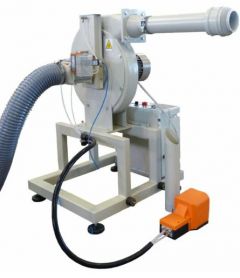 K-1322 CUSHION FILLING MACHINETHIS MACHINE PROVIDED WITH A BRAKING SYSTEM WHICH PERMITS THE FILLING OF WADDING PILLOWS AND QUILTS WITH ALL MATERIALS (POLYESTER, FEATHER, EXPANDED POLYURETHANE, COTTON, WOOL, ETC.) THE PARTICULAR WIDENED SHAPE OF THE TURBINE MAKES IT POSSIBLE TO OBTAIN REMARKABLE PERFORMANCES IN THE FILLING UP USING THE SPECIAL TUBE IT IS POSSIBLE TO SUCK UP THE MATERIAL DIRECTLY FROM THE VARIOUS CONTAINERS. THE BRAKING IS VERY RAPID (ABOUT 1/10 OF SECOND) AND DOES NOT REQUIRE MAINTENANCE SINCE IT IS OBTAINED THROUGH A PNEUMATIC DEVICE. THE CONTROL DEVICE IS A PNEUMATIC FOOT-LEVER WHICH LEAVES THE OPERATOR’S HANDS UNENGAGED. SAFETY MOTOR PROTECTOR SWITCH. IT CAN BE SUPPLIED BOTH IN A ONE-PHASE AND IN A THREE-PHASE VERSION. THE MACHINE IS CONSTRUCTED IN CONFORMITY WITH THE EEC DIRECTIVES 2006/42/CE, 2004/108/CE E 2006/95/CE AND SUCCESSIVE MODIFICATIONS AND MARKED CE. ON REQUEST WITH SPEED VARIATION THE FAN SPEED IS ADJUSTABLE FROM 2000 TO 4200 RPM, IN ORDER TO OPTIMIZE THE SPEED OF FILLING TO THE SHAPE AND THE SIZE OF THE PILLOW AT MAXIMUM SPEED, THE AMOUNT OF MATERIAL FILLED IS ABOUT 200 GRAMS PER SECOND. ON THE PART OF THE MACHINE THE LOAD OF THE MATERIAL, THERE ARE 2 DAMPERS. THIS PREVENTS THE OVERLOADING OF THE TURBINE AND THE BLOCK OF MATERIAL, BECAUSE WHEN I RELASE THE PEDAL, FIRST I BLOCK THE FLOW OF MATERIAL AND THEN THE AIR FLOW. THE PARTICULAR SHAPE OF THE OUTLET PIPE ALLOWS TO FILL THE PILLOWS THAT HAVE AIR-TIGHT LINING. THE TURBINE IS MADE OF A CAST ALUMINUM. THE COMMAND TO THE DUMPERS IS GIVEN BY A PEDAL, SO THE OPERATOR HAS BOTH HANDS FREE. THE APPLICATION OF THE GRIPPERS ON THE OUTLET PIPE OF THE FILLER R 3PV ALLOWS A SINGLE OPERATOR TO USE MORE FILLERS. FURTHERMORE, IT IS POSSIBLE CHANGE THE TIME THAT THE GRIPPERS STAY CLOSED. THIS ALLOWS TO SET THE AMOUNT OF MATERIAL TO PUT INSIDE HE PILLOW, WITH A GOOD PRECISION. THE TIME IS ADJUSTABLE TO FILL DIFFERENT KINDS OF PILLOWS WITH DIFFERENT AMOUNTS OF MATERIAL. QUANTITY: 1 Learn More
K-1322 CUSHION FILLING MACHINETHIS MACHINE PROVIDED WITH A BRAKING SYSTEM WHICH PERMITS THE FILLING OF WADDING PILLOWS AND QUILTS WITH ALL MATERIALS (POLYESTER, FEATHER, EXPANDED POLYURETHANE, COTTON, WOOL, ETC.) THE PARTICULAR WIDENED SHAPE OF THE TURBINE MAKES IT POSSIBLE TO OBTAIN REMARKABLE PERFORMANCES IN THE FILLING UP USING THE SPECIAL TUBE IT IS POSSIBLE TO SUCK UP THE MATERIAL DIRECTLY FROM THE VARIOUS CONTAINERS. THE BRAKING IS VERY RAPID (ABOUT 1/10 OF SECOND) AND DOES NOT REQUIRE MAINTENANCE SINCE IT IS OBTAINED THROUGH A PNEUMATIC DEVICE. THE CONTROL DEVICE IS A PNEUMATIC FOOT-LEVER WHICH LEAVES THE OPERATOR’S HANDS UNENGAGED. SAFETY MOTOR PROTECTOR SWITCH. IT CAN BE SUPPLIED BOTH IN A ONE-PHASE AND IN A THREE-PHASE VERSION. THE MACHINE IS CONSTRUCTED IN CONFORMITY WITH THE EEC DIRECTIVES 2006/42/CE, 2004/108/CE E 2006/95/CE AND SUCCESSIVE MODIFICATIONS AND MARKED CE. ON REQUEST WITH SPEED VARIATION THE FAN SPEED IS ADJUSTABLE FROM 2000 TO 4200 RPM, IN ORDER TO OPTIMIZE THE SPEED OF FILLING TO THE SHAPE AND THE SIZE OF THE PILLOW AT MAXIMUM SPEED, THE AMOUNT OF MATERIAL FILLED IS ABOUT 200 GRAMS PER SECOND. ON THE PART OF THE MACHINE THE LOAD OF THE MATERIAL, THERE ARE 2 DAMPERS. THIS PREVENTS THE OVERLOADING OF THE TURBINE AND THE BLOCK OF MATERIAL, BECAUSE WHEN I RELASE THE PEDAL, FIRST I BLOCK THE FLOW OF MATERIAL AND THEN THE AIR FLOW. THE PARTICULAR SHAPE OF THE OUTLET PIPE ALLOWS TO FILL THE PILLOWS THAT HAVE AIR-TIGHT LINING. THE TURBINE IS MADE OF A CAST ALUMINUM. THE COMMAND TO THE DUMPERS IS GIVEN BY A PEDAL, SO THE OPERATOR HAS BOTH HANDS FREE. THE APPLICATION OF THE GRIPPERS ON THE OUTLET PIPE OF THE FILLER R 3PV ALLOWS A SINGLE OPERATOR TO USE MORE FILLERS. FURTHERMORE, IT IS POSSIBLE CHANGE THE TIME THAT THE GRIPPERS STAY CLOSED. THIS ALLOWS TO SET THE AMOUNT OF MATERIAL TO PUT INSIDE HE PILLOW, WITH A GOOD PRECISION. THE TIME IS ADJUSTABLE TO FILL DIFFERENT KINDS OF PILLOWS WITH DIFFERENT AMOUNTS OF MATERIAL. QUANTITY: 1 Learn More -
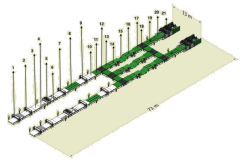 K-5014 HOTMELT GLUING MATTRESS PRODUCTION LINE 2200mm 1000 MATTRESSES PER 8-HOUR SHIFTREFERENCE NUMBER: K-5014 HOTMELT GLUING MATTRESS PRODUCTION LINE 2200mm 1000 MATTRESSES PER 8-HOUR SHIFT MAXIMUM WIDTH: 2200mm CAPACITY: 1,000 MATTRESSES PER 8-HOUR SHIFT 1ST BRIDGE: 3 PNEUMATICALLY MOVING GUNS WITH 4 NOZZLES ON EACH HOTMELT GUN. CAN BE CONVERTED TO SPRAY AT NO EXTRA COST. 2ND BRIDGE: 2 GUNS FOR THE EDGE: ONE HAS 8 NOZZLES (T-SHAPED), THE OTHER HAS 4 NOZZLES. 3RD BRIDGE: 3 PNEUMATICALLY MOVING GUNS. THEY ARE SPRAY; LINE NOZZLES CAN BE ADDED 4TH BRIDGE: EXACTLY THE SAME AS 3RD BRIDGE. FLOORSPACE DIMENSIONS: 72000mm X 13000mm QUANTITY AVAILABLE: 1 Learn More
K-5014 HOTMELT GLUING MATTRESS PRODUCTION LINE 2200mm 1000 MATTRESSES PER 8-HOUR SHIFTREFERENCE NUMBER: K-5014 HOTMELT GLUING MATTRESS PRODUCTION LINE 2200mm 1000 MATTRESSES PER 8-HOUR SHIFT MAXIMUM WIDTH: 2200mm CAPACITY: 1,000 MATTRESSES PER 8-HOUR SHIFT 1ST BRIDGE: 3 PNEUMATICALLY MOVING GUNS WITH 4 NOZZLES ON EACH HOTMELT GUN. CAN BE CONVERTED TO SPRAY AT NO EXTRA COST. 2ND BRIDGE: 2 GUNS FOR THE EDGE: ONE HAS 8 NOZZLES (T-SHAPED), THE OTHER HAS 4 NOZZLES. 3RD BRIDGE: 3 PNEUMATICALLY MOVING GUNS. THEY ARE SPRAY; LINE NOZZLES CAN BE ADDED 4TH BRIDGE: EXACTLY THE SAME AS 3RD BRIDGE. FLOORSPACE DIMENSIONS: 72000mm X 13000mm QUANTITY AVAILABLE: 1 Learn More -
 G-6398 HEAVY DUTY PILLOWING FILLING MACHINE (1 OPENER & 4 STUFFERS) 1400LBS/HOURREFERENCE NUMBER: G-6398 HEAVY DUTY PILLOWING FILLING MACHINE(1 OPENER & 4 STUFFERS) 1400LBS/HOUR THE PILLOW MACHINE LINE IS ASSEMBLED WITH A FIBER OPENER AND MINI BLOWER STUFFING MACHINES THAT MAINLY USED FOR TEXTILE STUFFING PRODUCTIONS SUCH AS BIG PLUSH TOYS, CUSHIONS AND PILLOWS ETC. IT CAN BE ALSO USED FOR FIBER QUILTING FILLING AFTER THE STUFFING SLOTS OF DUVET TYPE QUILTS - ADJUSTABLE FOOT SWITCH CONTROLLING FOR THE MATERIAL INSIDE OF THE STUFFER HOPPER THAT AVOIDS THE MATERIAL TO BALL UP. SO THAT THE FINISHED PRODUCT IS RETAINS GOOD ELASTICITY - LOW AIR PRESSURE REQUIRED. - HIGH PRODUCTIVITY QUANTITY AVAILABLE: 1 Learn More
G-6398 HEAVY DUTY PILLOWING FILLING MACHINE (1 OPENER & 4 STUFFERS) 1400LBS/HOURREFERENCE NUMBER: G-6398 HEAVY DUTY PILLOWING FILLING MACHINE(1 OPENER & 4 STUFFERS) 1400LBS/HOUR THE PILLOW MACHINE LINE IS ASSEMBLED WITH A FIBER OPENER AND MINI BLOWER STUFFING MACHINES THAT MAINLY USED FOR TEXTILE STUFFING PRODUCTIONS SUCH AS BIG PLUSH TOYS, CUSHIONS AND PILLOWS ETC. IT CAN BE ALSO USED FOR FIBER QUILTING FILLING AFTER THE STUFFING SLOTS OF DUVET TYPE QUILTS - ADJUSTABLE FOOT SWITCH CONTROLLING FOR THE MATERIAL INSIDE OF THE STUFFER HOPPER THAT AVOIDS THE MATERIAL TO BALL UP. SO THAT THE FINISHED PRODUCT IS RETAINS GOOD ELASTICITY - LOW AIR PRESSURE REQUIRED. - HIGH PRODUCTIVITY QUANTITY AVAILABLE: 1 Learn More -
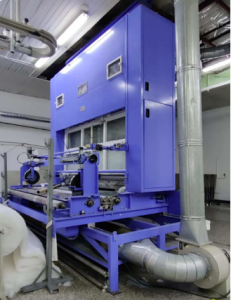 YY-2112 MASIAS SAD 3000 DIRECT FEEDING LINE SYSTEM FOR QUILTS, WADDINGS & SPECIAL NEEDLEPUNCHED PRODUCTS, YEAR 2004YY-2112 MASIAS SAD 3000 DIRECT FEEDING LINE SYSTEM FOR QUILTS, WADDINGS & SPECIAL NEEDLEPUNCHED PRODUCTS, YEAR 2004 HIGH PRODUCTION DIRECT FEEDING SYSTEM MADE BY MASIAS ON 2004 SUITABLE FOR THE PRODUCTION OF QUILTS (DUVETS & MATTRESSES) AND/OR WADDING. ALSO, SOME NEEDLEPUNCHED SPECIAL PRODUCTS FOR FURNITURE/MATTRESSES/TRANSPORT PROTECTION. Learn More
YY-2112 MASIAS SAD 3000 DIRECT FEEDING LINE SYSTEM FOR QUILTS, WADDINGS & SPECIAL NEEDLEPUNCHED PRODUCTS, YEAR 2004YY-2112 MASIAS SAD 3000 DIRECT FEEDING LINE SYSTEM FOR QUILTS, WADDINGS & SPECIAL NEEDLEPUNCHED PRODUCTS, YEAR 2004 HIGH PRODUCTION DIRECT FEEDING SYSTEM MADE BY MASIAS ON 2004 SUITABLE FOR THE PRODUCTION OF QUILTS (DUVETS & MATTRESSES) AND/OR WADDING. ALSO, SOME NEEDLEPUNCHED SPECIAL PRODUCTS FOR FURNITURE/MATTRESSES/TRANSPORT PROTECTION. Learn More -
 G-6402 AUTOMATIC PILLOWING FILLING MACHINE WITH AUTOMATIC SEALINGREFERENCE NUMBER: G-6402 AUTOMATIC PILLOWING FILLING MACHINE WITH AUTOMATIC SEALING THE PILLOW MACHINE LINE IS ASSEMBLED WITH A FIBER OPENER AND MINI BLOWER STUFFING MACHINES THAT MAINLY USED FOR TEXTILE STUFFING PRODUCTIONS SUCH AS BIG PLUSH TOYS, CUSHIONS AND PILLOWS ETC. IT CAN BE ALSO USED FOR FIBER QUILTING FILLING AFTER THE STUFFING SLOTS OF DUVET TYPE QUANTITY AVAILABLE: 1 Learn More
G-6402 AUTOMATIC PILLOWING FILLING MACHINE WITH AUTOMATIC SEALINGREFERENCE NUMBER: G-6402 AUTOMATIC PILLOWING FILLING MACHINE WITH AUTOMATIC SEALING THE PILLOW MACHINE LINE IS ASSEMBLED WITH A FIBER OPENER AND MINI BLOWER STUFFING MACHINES THAT MAINLY USED FOR TEXTILE STUFFING PRODUCTIONS SUCH AS BIG PLUSH TOYS, CUSHIONS AND PILLOWS ETC. IT CAN BE ALSO USED FOR FIBER QUILTING FILLING AFTER THE STUFFING SLOTS OF DUVET TYPE QUANTITY AVAILABLE: 1 Learn More -
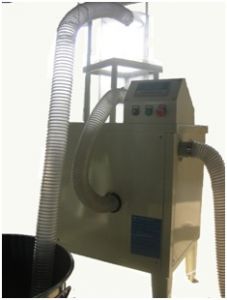 G-6734-F F-4-D FEATHER FILLING MACHINEMACHINE MODE: F -4-D ESPECIALLY SUITED FOR FILLING QUILTS DIMENSIONS: 700 x 600 x 1400mm POWER: 1.6KW FILLING RANGE: 1 TO 100 GRAMS, DEPENDING ON THE MATERIAL ACCURACY: O TO 3 GRAMS DEPENDING ON THE OPERATION WEIGHING AND FILLING WITH ONLY ONE MACHINE, IN ONLY ONE OPERATION, RELIABLE AND PRECISE. EASY AND FAULTLESS OPERATION BY PROGRAMMING, YOU CAN SET FILLING WEIGHT AND SAVE UP TO 20 RECIPES LOW NOISE, USES A SPECIAL FAN FOR GENTLE FEATHER PROCESSING TRANSPORTATION AT EXTREMELY HIGH PERFORMANCE. VARIABLE FILLING SPEED, QUICK-START AND QUICK-BRAKE OF THE FAN BY USE OF A FREQUENCY INVERTER. FOOT-SWITCH OPERATED, AUTOMATIC FINISH OF THE FILLING CYCLE Learn More
G-6734-F F-4-D FEATHER FILLING MACHINEMACHINE MODE: F -4-D ESPECIALLY SUITED FOR FILLING QUILTS DIMENSIONS: 700 x 600 x 1400mm POWER: 1.6KW FILLING RANGE: 1 TO 100 GRAMS, DEPENDING ON THE MATERIAL ACCURACY: O TO 3 GRAMS DEPENDING ON THE OPERATION WEIGHING AND FILLING WITH ONLY ONE MACHINE, IN ONLY ONE OPERATION, RELIABLE AND PRECISE. EASY AND FAULTLESS OPERATION BY PROGRAMMING, YOU CAN SET FILLING WEIGHT AND SAVE UP TO 20 RECIPES LOW NOISE, USES A SPECIAL FAN FOR GENTLE FEATHER PROCESSING TRANSPORTATION AT EXTREMELY HIGH PERFORMANCE. VARIABLE FILLING SPEED, QUICK-START AND QUICK-BRAKE OF THE FAN BY USE OF A FREQUENCY INVERTER. FOOT-SWITCH OPERATED, AUTOMATIC FINISH OF THE FILLING CYCLE Learn More
